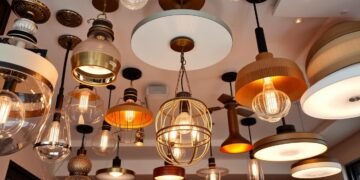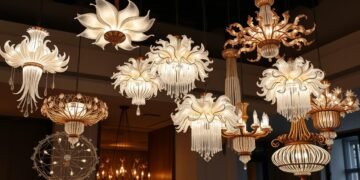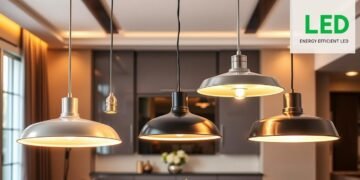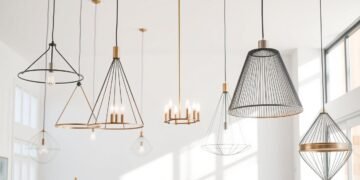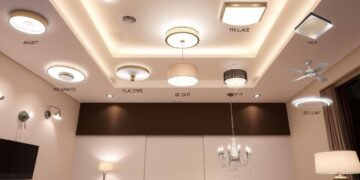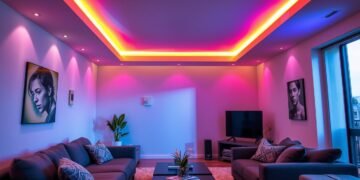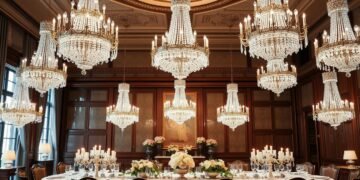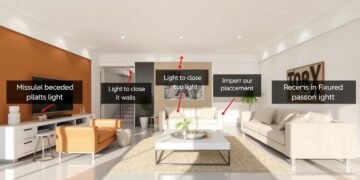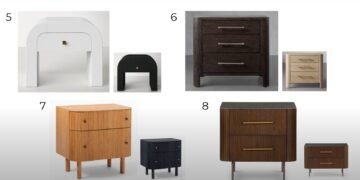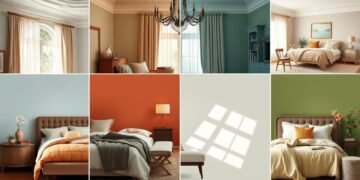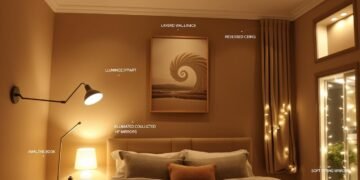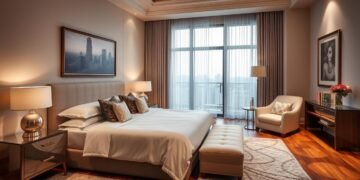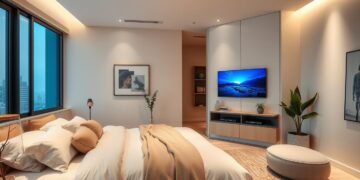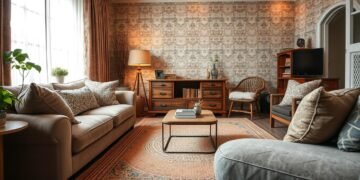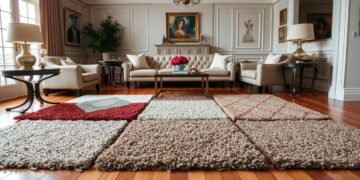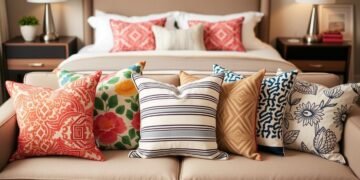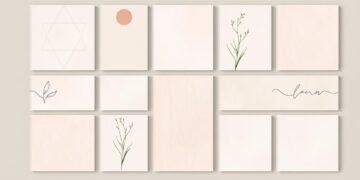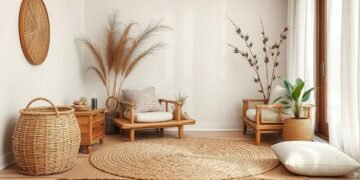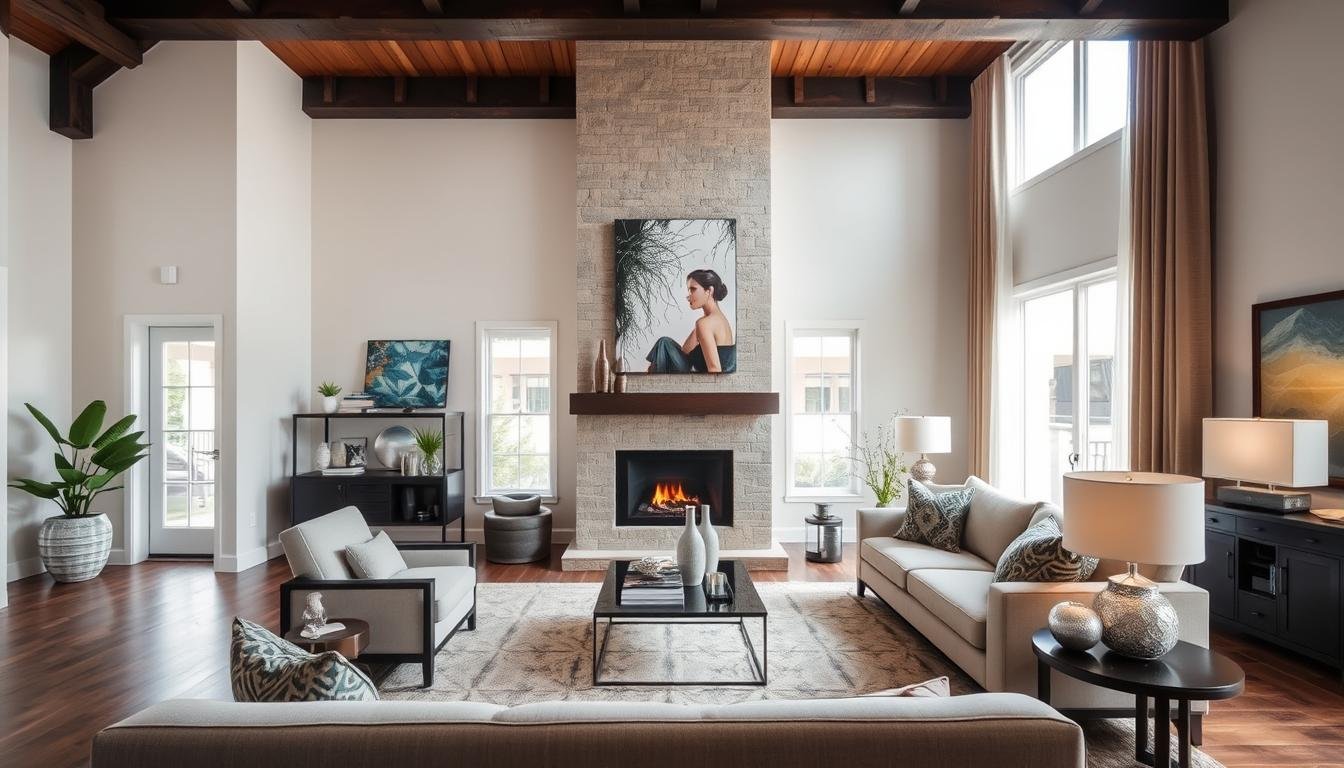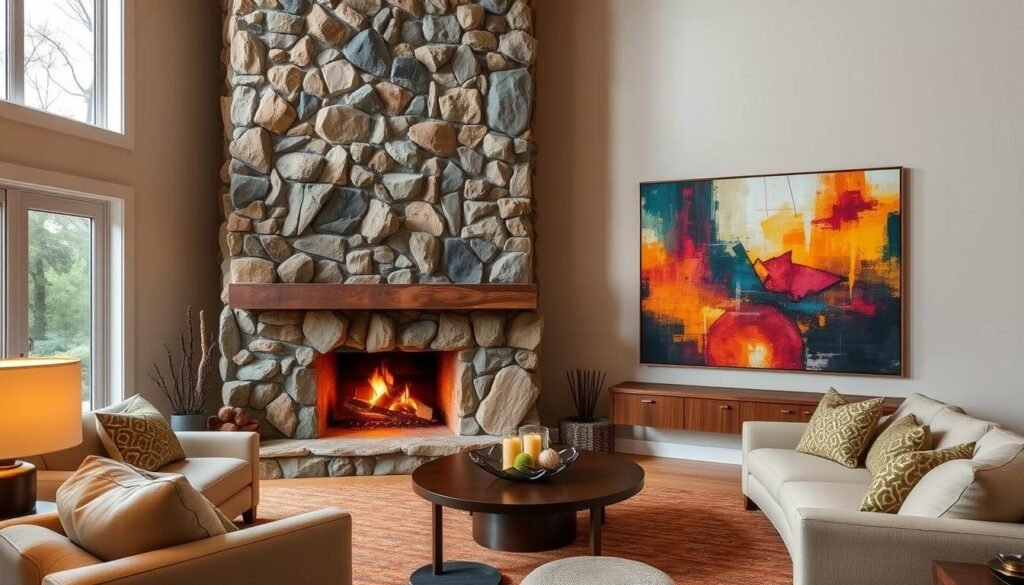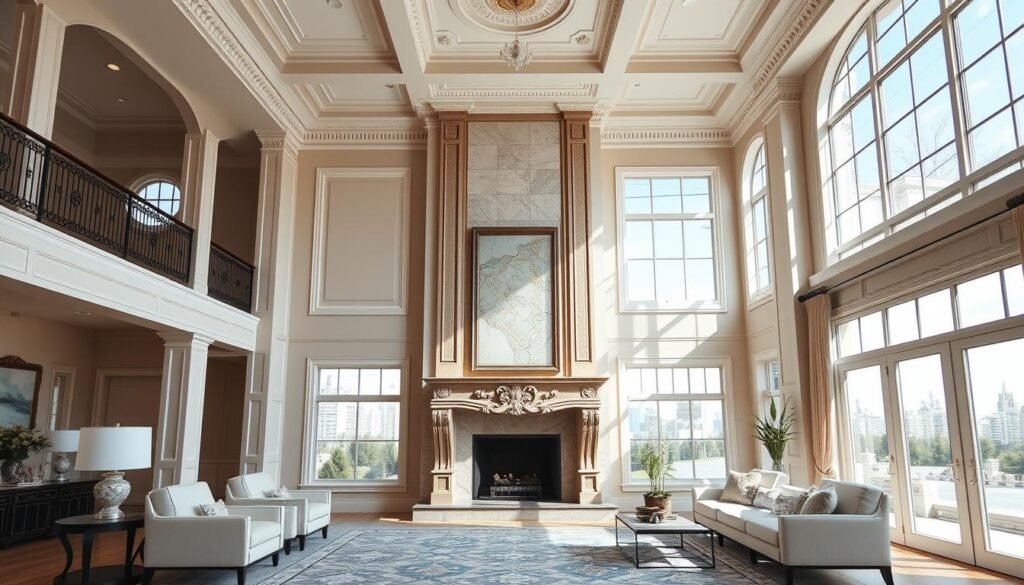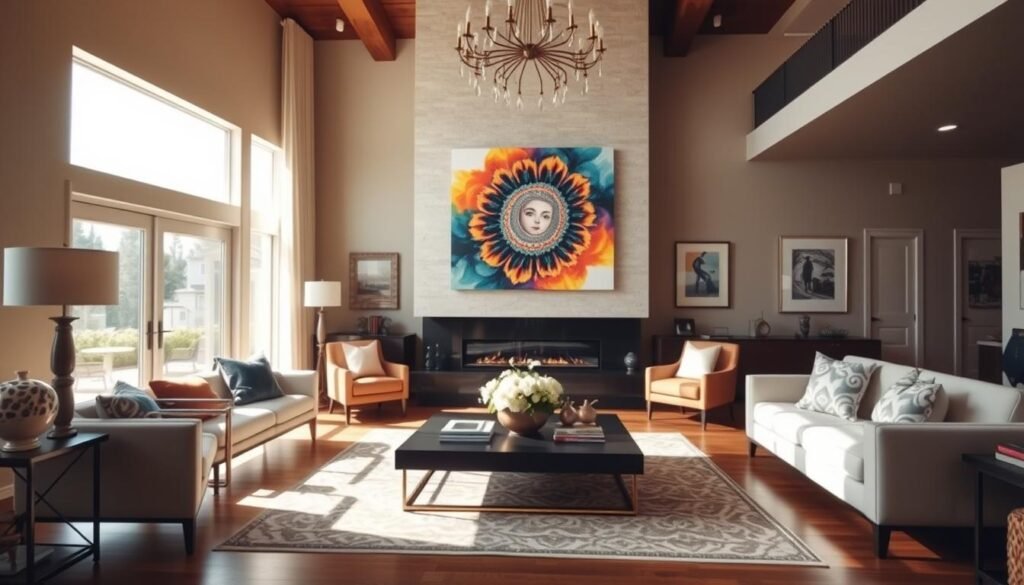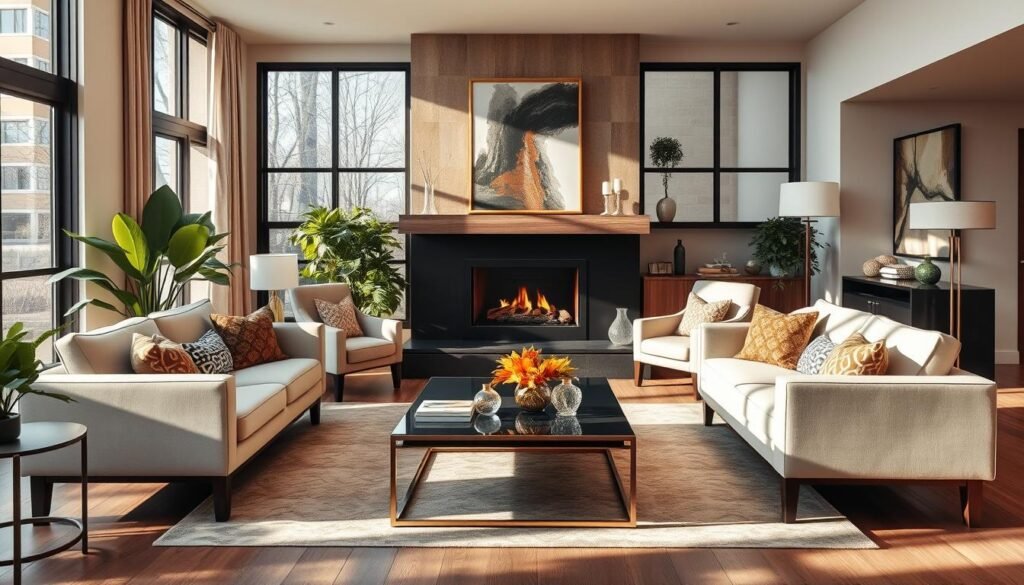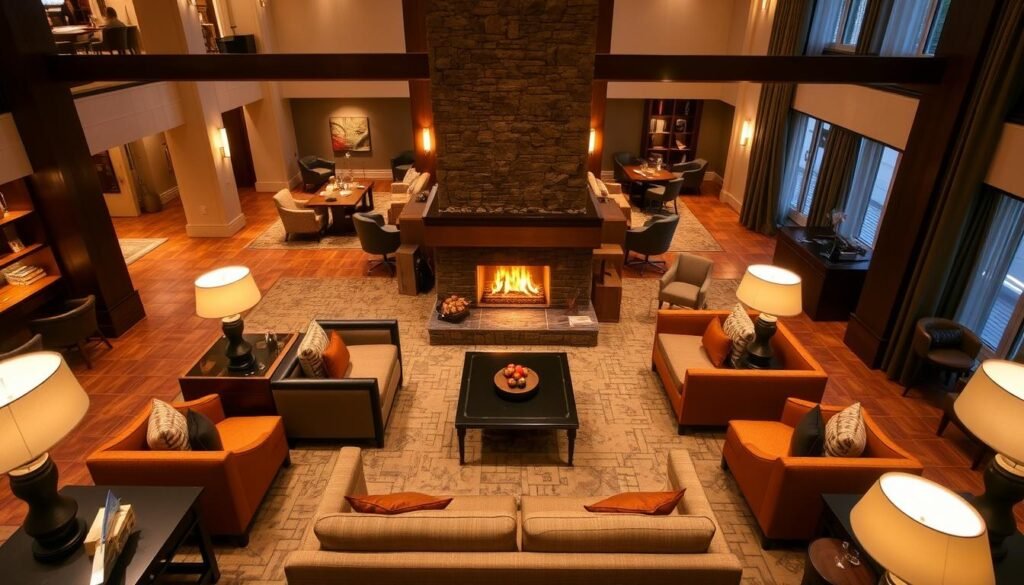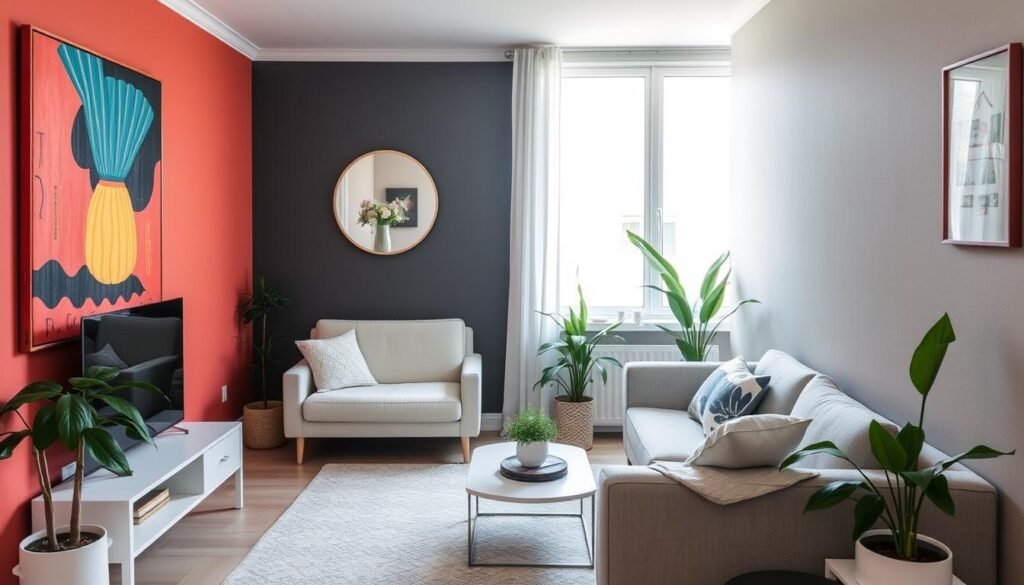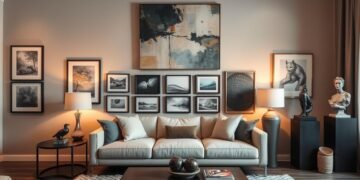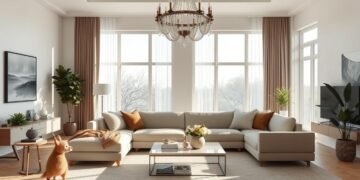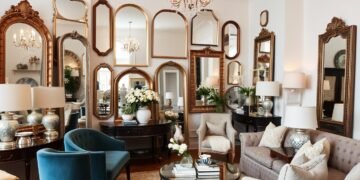When you’re in your living room, your eyes often land on a special spot. It might be a beautiful piece of art, a grand fireplace, or a stunning view. This focal point is the room’s heart, drawing your eye and setting the mood. But how do you pick the perfect focal point to make your room a visual masterpiece?
Table of Contents
- 1 Understanding the Power of Focal Points in Interior Design
- 1.1 The Psychology Behind Visual Anchors
- 1.2 Relatedarticles
- 1.3 7 Rules for Placing Artwork at the Right Height and Scale
- 1.4 5 Common Scale Mistakes and How to Correct Them
- 1.5 8 Tips for Using Mirrors to Enhance Proportion and Focus
- 1.6 How Focal Points Impact Room Flow
- 1.7 Benefits of Well-Defined Focal Points
- 2 Natural vs. Created Focal Points in Room Design
- 3 Architectural Features as Primary Focal Points
- 4 Choosing a Room’s Focal Point
- 5 Furniture Arrangement Strategies Around Focal Points
- 6 Using Color and Lighting to Enhance Focal Points
- 7 Art and Decorative Elements as Statement Pieces
- 8 Multiple Focal Points in Large Spaces
- 9 Working with Small Rooms and Limited Space
- 10 Conclusion
- 11 FAQ
- 11.1 What is the role of a focal point in interior design?
- 11.2 How do focal points impact room flow and atmosphere?
- 11.3 What are the benefits of having a well-defined focal point in a room?
- 11.4 What are the differences between natural and created focal points?
- 11.5 How can architectural features be used as focal points?
- 11.6 What factors should be considered when selecting a focal point?
- 11.7 How can furniture arrangement enhance a room’s focal point?
- 11.8 What design techniques can be used to emphasize a focal point?
- 11.9 How can multiple focal points be incorporated in a room?
- 11.10 How can focal points be effectively used in small spaces?
- 12 Source Links
Key Takeaways
- Focal points are the center of interest and activity in a room, commanding attention and setting the tone.
- The ideal focal point should be large, attractive, and immediately noticeable to anyone who enters the space.
- Examples of focal points include architectural features, furniture arrangements, views, and decorative elements.
- Choosing the right focal point can significantly enhance the overall appeal and functionality of a room.
- Strategically arranging furniture and using color, lighting, and accessories can help create and emphasize the focal point.
Understanding the Power of Focal Points in Interior Design
Focal points are the visual anchors of a room. They highlight the best features and create balance. These design elements guide the eye, making the space more inviting and appealing.
Well-defined focal points can improve room flow and visual interest. They also instill a feeling of order for those who occupy the space.
The Psychology Behind Visual Anchors
The psychological impact of focal points is significant. They guide the viewer’s gaze to the room’s most captivating aspects. By establishing a visual center, focal points create a sense of comfort and organization.
This allows occupants to fully engage with and appreciate the space.
How Focal Points Impact Room Flow
Properly positioned focal points can dramatically influence a room’s flow and functionality. They serve as natural gathering points, directing traffic and encouraging interaction. Well-executed focal points can enhance the overall user experience.
They make a space feel purposeful and cohesive.
Benefits of Well-Defined Focal Points
- Enhance visual interest and create a sense of balance
- Improve room flow and functionality
- Highlight a room’s best architectural features or personal style
- Guide the eye and establish a visual center for the space
- Instill a sense of comfort and organization for occupants
Crafting a captivating focal point is a key step in elevating any room’s design. By understanding the power of these visual anchors, you can transform your living spaces. They become inviting, well-balanced sanctuaries that reflect your unique aesthetic and personality.
“A well-defined focal point is the heart and soul of any interior design, guiding the eye and elevating the overall ambiance of the space.”
– Interior Design Expert, Jane Doe
Natural vs. Created Focal Points in Room Design
Designing the perfect focal point in any room offers two main choices: natural or created. Natural focal points are the built-in architectural features like fireplaces, large windows, or unique structures. Created focal points are statement furniture, eye-catching artwork, or decorative accents placed to attract the eye.
Both natural and created focal points can greatly enhance a room’s design and flow. Your choice depends on the room’s features and the atmosphere you want. If your room has striking architectural elements, using them as focal points can highlight the space’s character. Or, placing a bold piece of furniture or artwork can add personality and a sense of design.
| Natural Focal Points | Created Focal Points |
|---|---|
|
|
The choice between natural and created focal points depends on your room’s features and desired look. Understanding both types can help you make a choice that improves your space’s interior architecture and room flow.
Architectural Features as Primary Focal Points
Interior design often highlights architectural elements as key focal points. Fireplaces, built-in bookcases, and large windows are examples. They draw attention and set the room’s mood.
Working with Fireplaces and Built-ins
Fireplaces add warmth and style to any room. Decorate the mantel with items that match the room’s color blocking and contrast and focus. Built-in shelves can also be focal points, showing off your style and space planning.
Maximizing Window Views
Large windows with great views are powerful focal points. They make rooms feel open. Use light window treatments to enhance the view and let in natural light.
Highlighting Structural Elements
Features like exposed beams or detailed ceilings are also focal points. Use lighting or a matching color palette to highlight them. This makes your space visually appealing and cohesive.
“Architectural elements like fireplaces, windows, and built-ins can instantly elevate a room’s design and create a stunning focal point that anchors the entire space.”
Choosing a Room’s Focal Point
When picking a focal point for your room, think about what makes it welcoming and useful. The focal point should catch your eye first, pulling you into the room. Without standout architectural features, use furniture, art, or decor to create a focal point.
Make sure your focal point fits the room’s purpose and style. A clear focal point changes how we see and use the space. It affects the visual weight and flow of the room.
- Look for natural focal points like fireplaces, built-in shelves, or big windows. Think about how to make them more appealing.
- Try using accent furniture or decorative accessories to create a strong focal point. Make sure it matches the space layout and room function.
- Use contrasting colors or textures to make the focal point pop. This creates a bold visual statement.
- Arrange furniture and lights to focus attention on the focal point. This makes the design cohesive and engaging.
| Focal Point Elements | Percentage of Designers Utilizing |
|---|---|
| Artwork (paintings, sculptures) | 75% |
| Fireplaces | 60% |
| Contrasting Colors/Textures | 70% |
| Furniture Arrangement | 85% |
| Leveraging Natural Focal Points | 50% |
By choosing and highlighting a focal point, you can make a room that’s both beautiful and functional. It shows off your style and improves the room function.
“A well-defined focal point is the key to a successful interior design. It’s what draws the eye and sets the tone for the entire space.”
Furniture Arrangement Strategies Around Focal Points
Arranging furniture to highlight a room’s focal point is key for a great look and function. By placing your furniture wisely, you can draw attention to the room’s visual dominance. This boosts the room’s spatial awareness.
Balance and Symmetry Principles
Think about balance and symmetry when setting up furniture around a focal point. A symmetrical setup can make a room feel calm and organized. On the other hand, an asymmetrical layout can add excitement and a lively vibe. Make sure the furniture’s size and shape balance each other out for harmony.
Creating Conversation Areas
In living rooms, set up furniture to make cozy conversation areas around the focal point, like a fireplace or eye-catching wall art placement. Place sofas and armchairs facing each other to encourage chatting and create a warm atmosphere. A centerpiece, like a coffee table, can help tie the area together.
Traffic Flow Considerations
Remember the room’s traffic flow when arranging furniture. Place pieces so they don’t block the way to the focal point. This keeps it easy to see and reach. Also, avoid blocking windows, doors, or other lighting design features that could steal the show.
By following these furniture arrangement tips, you can make a room that looks great and works well. It will show off your room’s focal point and improve the architectural styles and use of the space.
Using Color and Lighting to Enhance Focal Points
When designing a room, the focal point grabs your attention. To highlight your living room or bedroom focal point, use color and lighting wisely. Contrasting colors and smart lighting can make it stand out.
Try a bold accent wall or vibrant accessories against neutral tones. This contrast makes the focal point, like a fireplace or artwork, pop. Or, choose a color scheme that complements the area for a cohesive look.
Lighting is key in making focal points shine. Use track lighting, pendant lights, or spotlights to focus on the main area. Try different styles, like uplighting or wall sconces, to set the mood and highlight the focal point.
Recent studies show incandescent bulbs waste up to 90% of energy as heat. Today, minimalist lighting is popular, using hidden fixtures to enhance light effects. LEDs are energy-efficient and long-lasting, adding decorative flair.
By choosing colors and lighting carefully, you can boost any room’s focal point. This thoughtful design creates a space that’s both beautiful and intentional.
| Lighting Technique | Purpose |
|---|---|
| Track Lighting | Illuminates and highlights focal points |
| Pendant Lights | Draws attention to specific areas |
| Spotlights | Shines a spotlight on key elements |
| Uplighting | Creates a warm, inviting ambiance |
| Wall Sconces | Accentuates architectural features |
Color and lighting can transform any room. They can make your living room focal point, bedroom focal point, or any design element shine. Try these ideas to create a space that’s both stunning and personal.
Art and Decorative Elements as Statement Pieces
Art and decorative elements can make a room stand out. Large paintings, gallery walls, sculptures, or unique decor items grab attention. They set the mood for the whole space. The trick is to pick a piece that fits the theme and color scheme and really pops.
Gallery Wall Creation
Creating a gallery wall is a great way to make a focal point. A survey found that 60% of interior designers like layering art for depth. Make sure your gallery fills two-thirds to three-quarters of the wall for the best effect.
Selecting Statement Artwork
Interior designers often choose bold, abstract paintings, which are 45% of their go-tos. Sculptures and vibrant tapestries also make great focal points. The most important thing is to pick something that speaks to you and fits the room’s style.
Incorporating Mirrors and Reflective Surfaces
Mirrors and reflective surfaces can make a room feel bigger and brighter. 80% of designers say good lighting makes art pop. Place mirrors to reflect other highlights in the room, like a fireplace or artwork.
Using art and decor can make your space truly special. Whether it’s a bold gallery, a striking sculpture, or a well-placed mirror, the choices are endless. You can easily make a room’s center of attention with these elements.
Multiple Focal Points in Large Spaces
Designing large rooms gives you the chance to use more than one focal point. But, it’s important to make sure these points work well together. You need to decide which one is most important and arrange your furniture and decor around it.
In open-concept layouts, each area can have its own focal point. But, you also need something to tie the whole space together. Create different seating areas or groupings around each focal point. This lets you show off various architectural features or design elements without making the room feel too busy.
67% of living rooms with two focal points struggle with furniture arrangement and decor. Use negative space to make the room feel bigger and more open. Keep the visual balance to avoid one focal point overshadowing the others. Designers might choose symmetrical or asymmetrical furniture arrangements, depending on the room and focal points.
Use lighting to highlight specific focal points. Use repetition in design elements like color, shapes, and textures to bring harmony to different focal areas. Also, strategic contrast and variety in styles, textures, and colors near each focal point can help create distinct yet harmonious zones in the living room.
The designer says sometimes making a focal point is easy, but other times it takes more work. For example, using a neutral sofa to not distract from windows and fireplaces, and adding splashes of color to keep the eye moving. These are examples of how to design focal points.
Remember, each room should have only one focal point, except in very large spaces. Having more than one focal point can make a room feel unbalanced and disorganized. This can cause anxiety. To deal with multiple focal points, you can combine them, choose the main one, or make the secondary ones less noticeable.
Working with Small Rooms and Limited Space
In small rooms, pick one focal point to avoid feeling cramped. Use tall bookcases or curtains to make the room seem bigger. Mirrors can also make the space look larger and serve as a focal point.
For small rooms, the focal point should make the room feel bigger, not smaller. Think about furniture that does more than one thing, like an ottoman with storage or a daybed. Arranging your furniture well can make a small space feel welcoming and cozy.
Focal Point Ideas for Small Rooms
- Incorporate a large, striking piece of artwork as the room’s focal point
- Choose a statement light fixture, such as a chandelier or pendant, to draw the eye upwards
- Highlight an architectural feature, like a beautiful window or fireplace, as the room’s visual anchor
- Use a large, bold-patterned rug to define and ground the space
- Arrange furniture to create a cozy conversation area around a central focal point
Focus on one key focal point and use vertical space to make small rooms feel open and balanced. With creativity and planning, even the tiniest space can become a beautiful and useful area.
| Focal Point Approach | Potential Benefits | Considerations |
|---|---|---|
| Artwork as Focal Point | Adds visual interest, creates a conversation starter | Ensure artwork is proportional to the room size |
| Statement Light Fixture | Draws the eye upwards, creates a sense of drama | Choose a fixture that complements the room’s style |
| Architectural Feature | Highlights the room’s natural assets, creates a sense of balance | Ensure the feature is not overpowered by other elements |
| Patterned Rug | Defines the space, adds visual interest | Select a rug size that is proportional to the room |
| Furniture Arrangement | Creates a cozy, inviting atmosphere | Balance the furniture layout to avoid a cluttered look |
By carefully choosing a focal point for your small space, you can make it both beautiful and functional. Every square foot will count.
Conclusion
Making effective focal points is key to great room design. You can use natural features or add them with decor and furniture. The goal is to create a clear visual order that makes the space look good and work well.
Using color, lighting, and smart furniture placement can turn any room into a beautiful place. It’s important to find the right balance between the focal point and the rest of the room. Studies show that well-placed focal points make spaces look better and work better.
The art of making focal points is about adding your personal touch. Whether you’re how to create multiple focal points in a room, positioning furniture to enhance a focal point, or balancing the focal point with room symmetry, the aim is to create spaces that impress and engage everyone who sees them.
FAQ
What is the role of a focal point in interior design?
How do focal points impact room flow and atmosphere?
What are the benefits of having a well-defined focal point in a room?
What are the differences between natural and created focal points?
How can architectural features be used as focal points?
What factors should be considered when selecting a focal point?
How can furniture arrangement enhance a room’s focal point?
What design techniques can be used to emphasize a focal point?
How can multiple focal points be incorporated in a room?
How can focal points be effectively used in small spaces?
Source Links
- How to Stage Focal Points
- 14 Beautiful Focal Point Ideas for Living Rooms
- Capture the Eye: How to Identify and Work With Focal Points
- The Power of Focal Points: How to Create Eye-Catching Features in Your Interior Design | MAGIA GRANITE
- Creating Focal Points in Your Room with Paint | Custom Painting, Inc.
- What is the best way to determine the focal point of a room?
- Focal Point Tips For Beautiful Rooms
- The Art of Creating the Perfect Focal Point in Interior Design – Interior Design & Home Staging Jacksonville, FL Interiors Revitalized
- Why Creating a Dominate Focal Point in a Room is Important.
- Focal Point in Interior Design: 5 Ways to Highlight a Focus
- Tips for choosing a focal point for your space | The A&T Register
- Focal Point in Interior Design: 5 Ways to Highlight a Focus
- The Interior Design Institute
- Furniture Arrangement Tips: Focal Points, Traffic, Blocking | Guild Hall
- Strategies for Creating a Focal Point in Every Room
- Focal Point in Interior Design: 5 Ways to Highlight a Focus
- Feature-Focused Interior Design: Why Focal Points Matter
- Creating Visual Impact: Using Lighting for Emphasis in Interior Design
- How to Use Art as a Focal Point in a Room – Eden Gallery
- 5 statement pieces for the living room that make the perfect focal point
- Wall Art as a Focal Point: Creating Visual Interest with Statement Pieces in Interior Design
- How to Deal with Two Focal Points in a Living Room
- Solving Interior Design Issues: Too Many Focal Points – Stephanie Weitkamp
- How to Deal With Multiple Focal Points in a Room
- Establishing a Purpose & Focal Point for Your Room – The Inspired Room
- 31 Small-Space Solutions for Every Room in Your Home
- The Importance of Focal Points in Interior Design — SUKKHA INTERIOR DESIGN
- Creating a focal point for harmony, visual interest, and personal expression.
